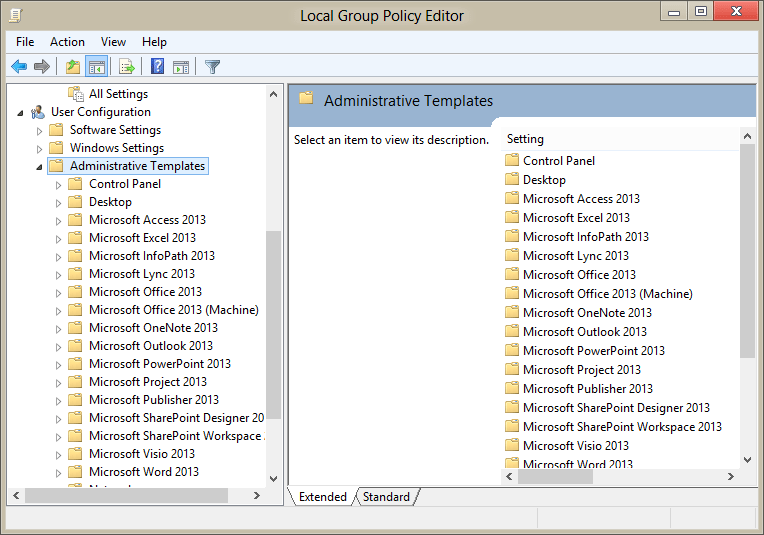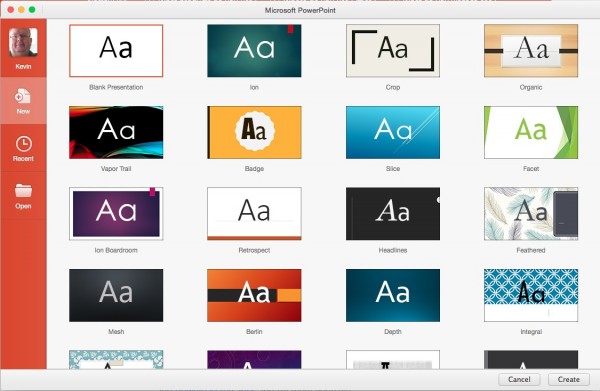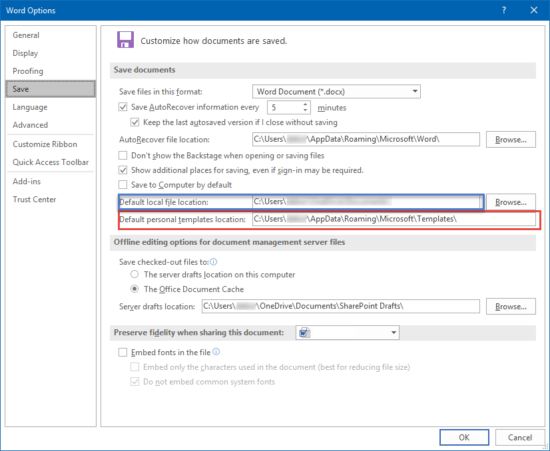Office 2016 Mac Template Location
Have you ever wondered how to change the default template that’s used to create the blank presentation as you open PowerPoint?
Microsoft Office applications. On tablets with Windows Mobile and the Office 2016 applications installed, you can customize the interface the same way as your Start menu. If you don’t have Office 2016 installed on your computing device, you can still create, view,. Support for Office 2016 for Mac ended on October 13, 2020. Upgrade to Microsoft 365 to work anywhere from any device and continue to receive support. The user templates location is stored in the UserTemplatesstring value. The workgroup templates location is stored in the SharedTemplates string value. These string values do not exist until you make a change to the default locations for your custom templates. By default, all Office programs look for their installed templates. The location is C: Documents and Settings Username Application Data Microsoft Templates Document Themes, as shown in Figure 2, below. Figure 2: Location of Themes in versions of PowerPoint on Windows XP Office 2016, 2011 or 2008 on Mac OS X. Although you can designate a My Themes folder in Office versions of the Mac, there is a default. Sometimes the evil lurks in what’s supposed to be Word 2016’s main repository of sanity: the Normal template file. To fix the Normal template, you must delete it (or rename it) and then Word automatically builds a new, proper Normal template. If you rebuild the Normal template, you’re removing any customizations you’ve added, macros you’ve.
It’s a fairly well hidden feature of PowerPoint that when it starts, it looks for a file called blank.potx. This filename cannot be altered and is fixed by PowerPoint and until recently, I thought the location of the file couldn’t be changed either. But that assumption changed during a conversation with John Korchock on the Microsoft’s Answers forum.

Before I continue, if you don’t know how to change the default template, take a look at this article from Steve Rindsberg which provides instructions for many different versions of PowerPoint.
Office 2016 Mac Os
The mysterious default location
For years, I was under the impression that the default location was hard coded in PowerPoint as follows:
%AppData%MicrosoftTemplates
The %AppData% part is an alias which when entered into the address bar of Windows File Explorer will map to your specific user data folder as in this example:
C:UsersJoeBloggsAppDataRoamingMicrosoftTemplates
Don’t get this location confused with Custom User Templates. From PowerPoint 2013, the location that templates get saved to when you create and save them as .potx files changed to:
C:UsersUserNameDocumentsCustom Office Templates

If you have templates there, they will be available in the backstage of PowerPoint when you click File / New under a tab named CUSTOM or PERSONAL (depending on the configuration of your Office installation). Saving your blank.potx file in this folder won’t get picked up by PowerPoint. Not by default anyway, but it could! Read on…
Here is the part I never knew
Microsoft PowerPoint can be used to change the location for the Custom User Templates by clicking File / Options / Save but it can’t be used to change the location that PowerPoint looks for the blank.potx file:
It’s not PowerPoint but Microsoft Word that sets the location for the blank.potx file (and Excel templates)! Now why didn’t I think of using Word to change a PowerPoint feature? Here’s how you can change it:
- Open Word
- Click File / Options / Advanced
- Scroll down to the General section
- Click File Locations
- Select User Templates
- Click Modify and set the desired path
Now when you open PowerPoint, it will look in this modified location for the blank.potx file. You might want to set this to the same location as your Custom User Templates or a different location.
So, if you’re having trouble setting the blank.potx file, open up Word and check to see if the user (or IT department) hasn’t changed this setting in Word, unaware that it affects the behaviour of PowerPoint (and Excel) too!
Geek Corner
If you need to know what’s going on under the hood, then this section’s for you but note, modifying the Windows Registry is a dangerous business and can completely render your PC inoperable. Proceed with caution!
When you use Word 2016 to modify the User Templates location, it creates a new registry key here:
HKCUSoftwareMicrosoftOffice16.0CommonGeneralUserTemplates
By default, this key doesn’t exist (part of the reason I never found it when searching for it in the past). And, if you set the location back to the default path, the key is deleted.
You can therefore change the default location outside of Office using the RegEdit.exe tool or by running specially crafted .reg files. But since we at YOUpresent create custom add-ins for PowerPoint, we’ll be adding a feature to check and modify this location in our latest product called YOUtools. It has over 50 handy tools that you and your design studio colleagues will wonder how you ever lived without them.
-->Note
Office 365 ProPlus is being renamed to Microsoft 365 Apps for enterprise. For more information about this change, read this blog post.
Introduction
This article describes the different types and locations of templates in 2007 Microsoft Office programs and in 2010 Office programs. Additionally, this article contains information about registry settings that control where you find custom templates.
More Information
Microsoft Office 2016 Mac Download

2007 Office programs and 2010 Office programs save all new custom templates that you create. A Microsoft Office program looks in one of the following locations for the templates that belong to that program:
- The user templates file location
- The workgroup templates file location
- The advertised and installed templates file location
- The non-file-based templates file location
User templates file location
Newly created or newly modified templates are saved in a folder in your profile directory. The folders that are under your profile contain your configuration preferences and options. These folders contain everything that is needed for a roaming user profile.
By default, user templates files are stored in the following location:
- In Windows XPC:Documents and Settings user name Application DataMicrosoftTemplates
- In Windows Vista or in Windows 7C:Users user name AppDataRoamingMicrosoftTemplates
Note You can change the location of user templates files.
How to change the location in which templates are saved
You can use Microsoft Office Word to change the location in which your new templates are saved. To do this, follow these steps.
Note If you use Word 2007 or Word 2010 to change the location in which your new templates are saved, you also change the location in which all 2007 Office program templates or all 2010 Office program templates are saved.
Start Word.
If you are using Word 2007, click the Microsoft Office Button, and then click Word Options.
If you are using Word 2010, choose Options from the Filemenu.
Click Advanced.
Under General, click File Locations.
Click User templates, and then click Modify.
In the Modify Location dialog box, change the setting in the Folder name list or the Look in list to the folder in which you want to save your new templates. Then, click OK.
Click OK or Close to close the Options dialog box.
The changed path is noted in the Windows registry. The path is used the next time that you want to save a new template. For more information, see the 'Changes in the Windows registry settings for the user templates file location and for the workgroup templates file location' section.
Note Your network administrator can change the location in which your new templates are saved by using the policy templates that are included with the 2007 Microsoft Office Resource Kit. For more information, contact your network administrator.
You can also create custom tabs that appear in the Templates dialog box by creating a new folder in the Templates folder in your profile. Tabs that have the same name as a new folder appear in the Templates dialog box. These tabs let you categorize your new templates even more.
The template options are available when you click the Microsoft Office Button, and then click New in Office 2007 or from New under the File menu in Office 2010.
Note There are more templates available in the Microsoft Office Online area.
Note Microsoft Office Publisher 2007 and Microsoft Office SharePoint Designer 2007 do not use the same user interface as the previously listed 2007 Office programs.
In Publisher 2007 or Publisher 2010
- On the File menu, click New, and then click one of the publication types.

In SharePoint Designer 2007
- On the File menu, click New, and then click one of the templates.
Workgroup templates file location
The templates that are saved in this location are basically the same as the templates that are saved in your user templates file location. However, the location is typically a shared folder on a network drive.
Note Your network administrator may set a shared location as a source from which to provide templates that are used throughout your workgroup or company. The workgroup template file location typically is a read-only shared folder.
In addition to looking in your default user templates file location for existing templates, 2007 and 2010 Office programs look in the workgroup templates file location for more templates.
For more information about the workgroup templates file location and about how to share a template with your workgroup or your company, contact your network administrator.
Advertised and installed templates file location
Advertised templates are the templates that are included with Office programs. These templates appear in the Templates dialog box. Depending on the type of Office installation, you may not have all the templates installed on the computer. However, each Office program displays the templates as they are available in the Templates dialog box.
When you select a template, the Office program determines whether the template is installed. If the template is installed, a new document that is based on the template opens. If the template is advertised but is not installed, the program prompts you to install the template.
You can remove installed templates for Publisher 2007 by starting the 2007 Office installation program. Then, set the template group to Installed on First Use. This effectively removes the templates from the computer. Then, the templates become advertised templates again. Microsoft Office Access 2007 does not allow for templates to be advertised. However, templates can be set to Not Available in Access 2007. The other 2007 Office programs do not list templates as a separate component.
By default, all templates that are installed with Microsoft Office are installed in the following folder:
C:Program FilesMicrosoft OfficeTemplates Language ID Number
Note The Language ID Number is a four-digit code that represents the language types that are currently installed. For example, the English (US) version of Office installs a 1033 folder. The Arabic version installs a 1025 folder. The German version installs a 1031 folder. 2007 Office programs support many other languages. Additionally, you can have multiple languages installed at the same time. Therefore, you may have a Templates folder that contains several language ID folders.
Non-file-based templates file location
Office programs use non-file-based templates to create new workbooks, documents, databases, and slides. As the name suggests, there is no physical template from which these special files are created. Each Office program has the necessary information to create a new file of the correct type.
For example, if the Word global template (Normal.dotm) is used to create a blank document, Word uses its internally stored settings to create a new blank document.
Changes in the Windows registry settings for the user templates file location and for the workgroup templates file location

Important
This section, method, or task contains steps that tell you how to modify the registry. However, serious problems might occur if you modify the registry incorrectly. Therefore, make sure that you follow these steps carefully. For added protection, back up the registry before you modify it. Then, you can restore the registry if a problem occurs. For more information about how to back up and restore the registry, see How to back up and restore the registry in Windows.
Office programs use two registry keys to record the user templates file location and the workgroup templates file location. Both settings are recorded in the following registry key:
Office 2007:
HKEY_CURRENT_USERSoftwareMicrosoftOffice12.0CommonGeneral
Office 2010:
HKEY_CURRENT_USERSoftwareMicrosoftOffice14.0CommonGeneral
The user templates location is stored in the UserTemplatesstring value.
The workgroup templates location is stored in the SharedTemplates string value.
These string values do not exist until you make a change to the default locations for your custom templates. By default, all Office programs look for their installed templates. Therefore, no string value is required for Office programs.
If you change the user templates file location to the default location as described in the 'User templates file location' section, the UserTemplates string value is deleted from the registry. However, if you change the workgroup templates file location to the default location, the SharedTemplates string value is retained in the registry.